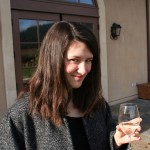Inside The New York Botanical Garden
Posted in Shop/Book Reviews on November 8 2010, by Plant Talk
 Much as you would expect from the editor of a website called Fashionista, Lauren Sherman is a stylish young woman. But, unlike some of her fashion news peers, Lauren steers clear of dressing in all black (most days) and gratuitous trends, opting instead for an eclectic, self-confident mix of girly and masculine that comes off as classically feminine.
Much as you would expect from the editor of a website called Fashionista, Lauren Sherman is a stylish young woman. But, unlike some of her fashion news peers, Lauren steers clear of dressing in all black (most days) and gratuitous trends, opting instead for an eclectic, self-confident mix of girly and masculine that comes off as classically feminine.
It’s a sensibility–inspired by much-loved trips to Europe with her technology-blogger fiancé and time spent living in London–that carries through to her “Favorite Things,” a list of gracious, classic gift picks from the Shop in the Garden.
See Lauren's picks below.
Posted in Exhibitions, Gardens and Collections, Programs and Events on November 8 2010, by Plant Talk
| Ann Rafalko is Director of Online Content. |
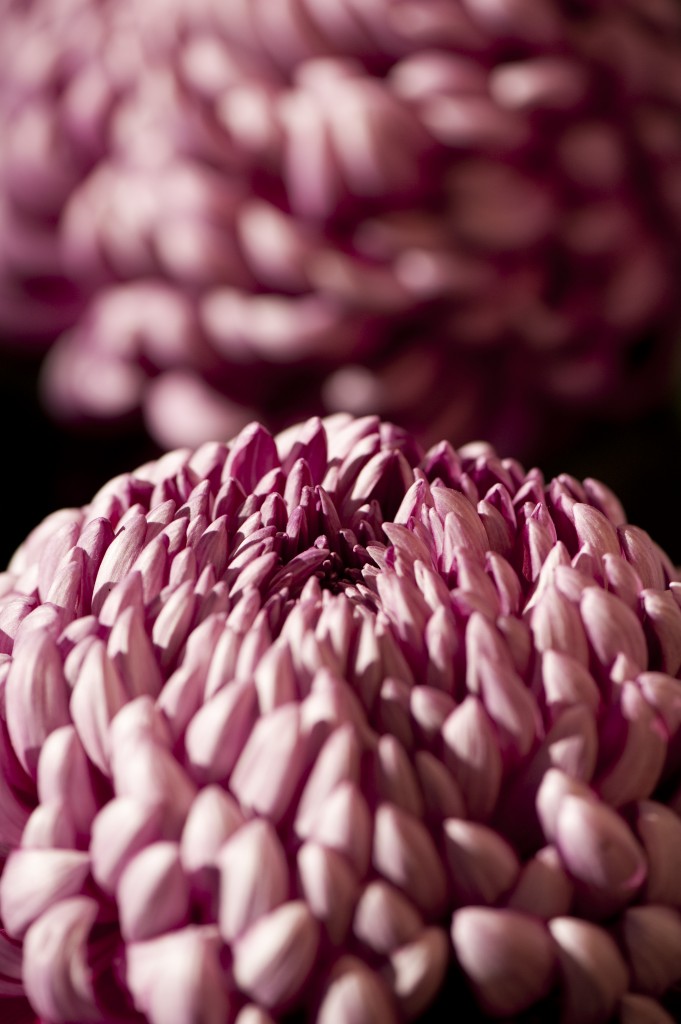 Chrysanthemums. You see them everywhere this time of year; their cheery little faces in a rainbow of hues (all except blue!) brightening up front stoops, fire escapes, tree guards, and otherwise bedraggled gardens all over the city. But trust us, you’ve never seen chrysanthemums like this!
Chrysanthemums. You see them everywhere this time of year; their cheery little faces in a rainbow of hues (all except blue!) brightening up front stoops, fire escapes, tree guards, and otherwise bedraggled gardens all over the city. But trust us, you’ve never seen chrysanthemums like this!
On display now for a limited time–just until Sunday, November 21–at the Bourke-Sullivan display house is a wonderland of Japanese chrysanthemums. These mums are far more than the plastic pots you can jump in your car and buy at your local gardening center. These mums are coddled and cultivated and trained and coaxed into a kaleidoscopic array of shapes–dizzying spirals, sprawling umbrellas, cascading waves–each form composed entirely of just one plant. That’s right. One plant.
See 464 blooms on one plant below.
Posted in Gardening Tips on November 8 2010, by Sonia Uyterhoeven
 |
Sonia Uyterhoeven is Gardener for Public Education. Join her each weekend for home gardening demonstrations on a variety of topics in the Home Gardening Center. |
By this time of year, you probably have begun saving seeds of your favorite annuals and vegetables. Seed saving is fairly straight forward as long as you follow a few simple rules.
When collecting seeds in your garden, look for healthy plants that possess the characteristics you desire. If you have a pot marigold (Calendula) with a pale apricot color that you admire, collect seeds from the paler specimens to try and keep the nice shade. You will always get variation, but you are participating in the selection process as, in essence, an amateur breeder.
Many of your flowers and vegetables are cross-pollinated, Mother Nature’s way of passing along diversity. If you want the seeds to be pure, isolate the plant (generally by building a cage or covering for it) or pollinate by hand, but this is generally only necessary for commercial growers or for seed-saving enterprises.
Most important is to always choose healthy plants so that you end up with healthy, viable seeds. Don’t waste your time collecting seeds from F1 hybrids. They will never come true to seed, and you will get some strange results. Heirloom varieties, on the other hand, tend to be fairly stable and are wonderful to collect.
Read More
Posted in Photography on November 8 2010, by Plant Talk
Those aren’t magic carpets. They’re giant rolls of sod.

Re-sodding the Conservatory Kitchen lawn (photo by Ivo M. Vermeulen).
Posted in Wildlife on November 5 2010, by Plant Talk
Owls, Hawks, Sparrows, Even Wild Turkeys, Seen on Free Weekly Walks
 |
Debbie Becker leads a free bird walk at the Garden every Saturday from 11 a.m. to 12:30 p.m., beginning at the Reflecting Pool in the Leon Levy Visitor Center. Photos by Debbie Becker.
|
 Fall arrives with a hint of winter and a longing for summer. The leaves fall and the trees begin to go dormant. For me and other birders, fall signifies transition with the migration of birds. The herons, egrets, and catbirds all leave for warmer climates. Their time in New York City has come to an end, and they flee before winter arrives. But with the fall, too, comes the arrival to New York of the winter birds: juncos, white-throated sparrows, chickadees, titmice, ducks, and owls. Some birders think that winter birding is the best, and it begins in the fall.
Fall arrives with a hint of winter and a longing for summer. The leaves fall and the trees begin to go dormant. For me and other birders, fall signifies transition with the migration of birds. The herons, egrets, and catbirds all leave for warmer climates. Their time in New York City has come to an end, and they flee before winter arrives. But with the fall, too, comes the arrival to New York of the winter birds: juncos, white-throated sparrows, chickadees, titmice, ducks, and owls. Some birders think that winter birding is the best, and it begins in the fall.
 Autumn is sparrow season, and this fall has proven to be a spectacular one at that. So far at NYBG we have spotted field, tree, clay-colored, song, white-crowned, swamp, savannah, chipping, and white-throated (pictured above) sparrows. Along with the flocks of sparrows are yellow-rumped warblers and an assortment of other migrating birds: common yellowthroats, blackpolls, American redstarts, ovenbirds (one pictured at left), black-and-white warblers, black-throated green warblers, black-throated blue warblers, grosbeaks, tanagers, and a variety of vireos and flycatchers.
Autumn is sparrow season, and this fall has proven to be a spectacular one at that. So far at NYBG we have spotted field, tree, clay-colored, song, white-crowned, swamp, savannah, chipping, and white-throated (pictured above) sparrows. Along with the flocks of sparrows are yellow-rumped warblers and an assortment of other migrating birds: common yellowthroats, blackpolls, American redstarts, ovenbirds (one pictured at left), black-and-white warblers, black-throated green warblers, black-throated blue warblers, grosbeaks, tanagers, and a variety of vireos and flycatchers.
We have also spotted overhead at Daffodil Hill migrating turkey vultures, osprey, Cooper’s hawks, sharp-shinned hawks, a kestrel, a rough-winged hawk, and a wonderful merlin that soared in the sunlight, illuminating the copper and red in its wings.
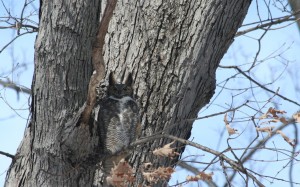 The great horned owls that now inhabit the Forest at NYBG are second generation, as the longtime resident male and female have since died. A junior male (pictured), a possible offspring of the pair, and a new mate have staked their territory. It is amazing to see the junior male roosting in the same spot where the former owls did. He carries on the tradition of hooting in the same Forest area; we look forward to seeing their owlets.
The great horned owls that now inhabit the Forest at NYBG are second generation, as the longtime resident male and female have since died. A junior male (pictured), a possible offspring of the pair, and a new mate have staked their territory. It is amazing to see the junior male roosting in the same spot where the former owls did. He carries on the tradition of hooting in the same Forest area; we look forward to seeing their owlets.
Yellow-bellied sapsuckers, a name that always elicits a laugh, are plentiful at the Garden as are other woodpeckers: hairy, downy, and a persistent red-bellied that can be observed by Twin Lakes. It flies back and forth, grabbing acorns from an oak and depositing them in an open knot in a tree, storing them for winter.
Chickadees and titmice have arrived in record numbers. Recently we watched a brown thrasher by the crabapples wandering up the road as a hermit thrush and eastern phoebe looked on. Cedar waxwings and robins that will spend the winter at the Garden were eating berries from a polycarpa tree. Grackles, which migrate in the thousands, have begun lighting on nearby lawns.
Before you start thinking about Thanksgiving, come see the two wild turkeys that are regularly seen behind Shop in the Garden. They peck and scrape the gravel and grass looking for morsels to feed on.
I look forward to cool days with misty air—and birds that delight us. Come join us on a walk.
Posted in Gardens and Collections on November 5 2010, by Plant Talk
| Ann Rafalko is Director of Online Content. |
The Gray Lady read our mind with today’s feature on leaf peeping in some of New York City’s hidden forest gems!
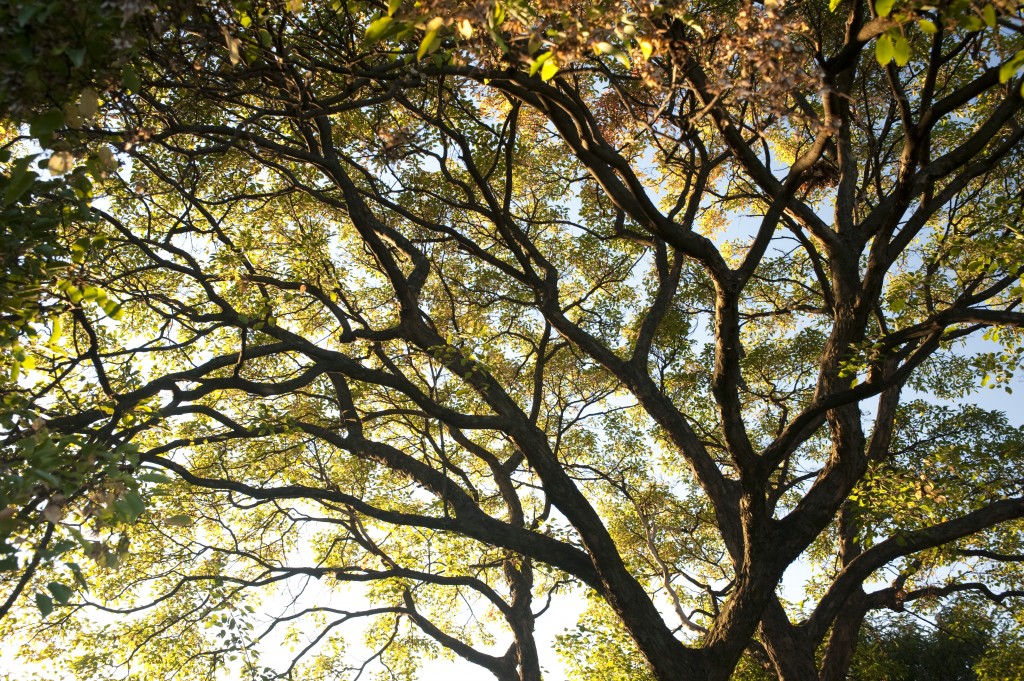
We’re thrilled and honored to have the Garden‘s Native Forest included in this piece, and couldn’t agree more that the City is a fantastic place to get out and marvel at the autumnal beauty of trees.
So much more beauty below the jump.
Posted in Photography on November 5 2010, by Plant Talk
The Garden is dressed up in autumnal finery. Why don’t you indulge in a little leaf peeping this weekend?
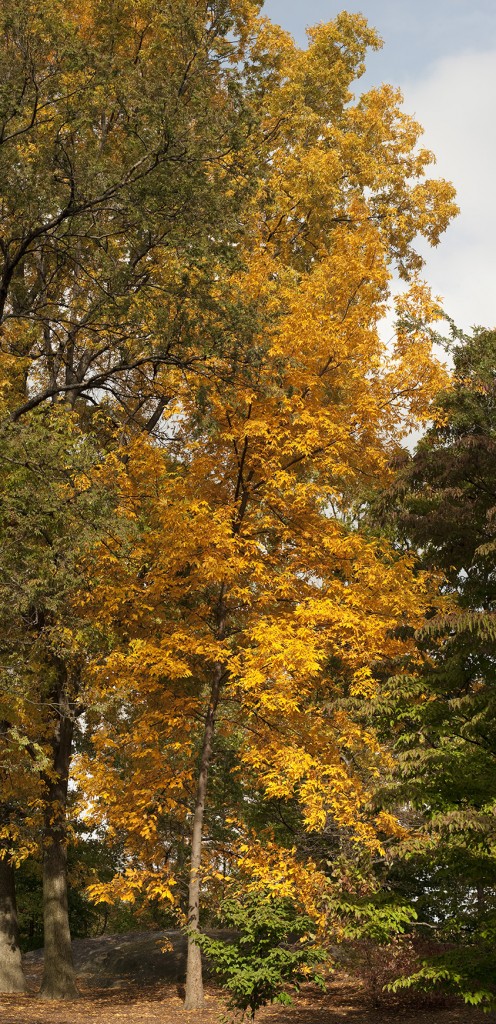
Fall Foliage (photo by Ivo M. Vermeulen).
Posted in Shop/Book Reviews on November 4 2010, by Plant Talk
 Olga Massov, creator of the popular cooking blog Sassy Radish, is a true triple threat: She’s a talented writer, photographer, and cook. Olga, a finance geek by day, writes about recipes and cooking in a way that makes you want to sit down with her and have a cup of coffee while working out what to cook for dinner. Her stories are sweet and lovely; her recipes simple, seasonal, and delicious.
Olga Massov, creator of the popular cooking blog Sassy Radish, is a true triple threat: She’s a talented writer, photographer, and cook. Olga, a finance geek by day, writes about recipes and cooking in a way that makes you want to sit down with her and have a cup of coffee while working out what to cook for dinner. Her stories are sweet and lovely; her recipes simple, seasonal, and delicious.
When we began our “Favorite Things” campaign for the Shop in the Garden, we knew we wanted to see what Olga would pick. And just like her blog, Olga’s list of holiday gifts for friends and family is warm, genuine, and delicious.
See Olga's picks below.
Posted in Gardens and Collections on November 4 2010, by Plant Talk
Roses aren’t just a summertime treat. The Peggy Rockefeller Rose Garden blooms multiple times throughout the year, bringing beauty and fragrance to those who — if you’ll pardon the expression — stop and smell the roses. While the flowers love the full sun and hot weather in the summertime, the award-winning Rose Garden thrives in fall with one last spectacular, “rose encore.” It’s the floral equivalent of a curtain call!
This will be your last chance to see these beauties in 2010. According to the Rose Garden curator Peter Kukielski, the rose garden will continue to flower until the first frost — which is unfortunately almost upon us in the Bronx. So while it’s too late to begin planting and too early to start training next year’s blooms, you’ve got this weekend to get one last look before the Rose Garden’s gates are closed until May 1st, 2011.
So if you can’t make it out this weekend to see for yourself, here’s a quick gallery of what you’re missing out on, including certain varieties named in honor of celebrities and dignitaries as well as dew covered morning beauties. All of the images are from Garden photographer Ivo M. Vermeulen (you kind find tons of his photos plus some by other talented photographers on our Flickr page. Don’t forget to submit your own to our group page too!)
Posted in Science on November 4 2010, by Plant Talk
Paying for Benefits Provided by Natural Systems May Help in Conservation
 |
Scott A. Mori, Ph.D., Nathaniel Lord Britton Curator of Botany, has been studying New World rain forests for The New York Botanical Garden for over 35 years. He has witnessed an unrelenting reduction in the extent of the tropical forests he studies and as a result has become interested in the ecosystem services provided by them. |
 |
Li Gao, a biology student at SUNY Binghamton, studied ecosystem services under the supervision of Dr. Mori as an intern at the Garden this past summer. |
Photo by C. Gracie: Fish harvested from nature is an example of an ecosystem service.
 For the past three years, the Institute of Systematic Botany of The New York Botanical Garden has been preparing an inventory of the plants of the Osa Peninsula of Costa Rica. Our goal is to document the native plants growing on the Osa through collections and images, most of which are the result of the botanical explorations of Costa Rican botanist Reinaldo Aguilar. The Osa is the last large expanse of lowland rain forest along the Pacific coast of all of Mesoamerica, and is a place where jaguars, large flocks of scarlet macaws, nesting sea turtles, and over 2,000 species of plants (821 of which are trees) can still be seen in their natural habitat.
For the past three years, the Institute of Systematic Botany of The New York Botanical Garden has been preparing an inventory of the plants of the Osa Peninsula of Costa Rica. Our goal is to document the native plants growing on the Osa through collections and images, most of which are the result of the botanical explorations of Costa Rican botanist Reinaldo Aguilar. The Osa is the last large expanse of lowland rain forest along the Pacific coast of all of Mesoamerica, and is a place where jaguars, large flocks of scarlet macaws, nesting sea turtles, and over 2,000 species of plants (821 of which are trees) can still be seen in their natural habitat.
Tropical forests boost local economies through the sale of tropical forest products like timber, chocolate, and Brazil nuts, but in the process of producing these products part of the original forest is modified, often harming the plants and animals that live there. Tropical forests, though, have value far beyond that derived from these obvious harvests. The fish found in their rivers and lakes and the animals living in their forests provide sources of protein for the local population. The rich diversity of plants and animals found in tropical forests as well as their scenic beauty make them a favorite destination for tourists. In addition, tropical forests are reservoirs of genetic diversity, play an important role in maintaining the stability of the world’s atmospheric gases, and help control hydrological cycles on local, regional, and global scales.
Read More
 Much as you would expect from the editor of a website called Fashionista, Lauren Sherman is a stylish young woman. But, unlike some of her fashion news peers, Lauren steers clear of dressing in all black (most days) and gratuitous trends, opting instead for an eclectic, self-confident mix of girly and masculine that comes off as classically feminine.
Much as you would expect from the editor of a website called Fashionista, Lauren Sherman is a stylish young woman. But, unlike some of her fashion news peers, Lauren steers clear of dressing in all black (most days) and gratuitous trends, opting instead for an eclectic, self-confident mix of girly and masculine that comes off as classically feminine.










